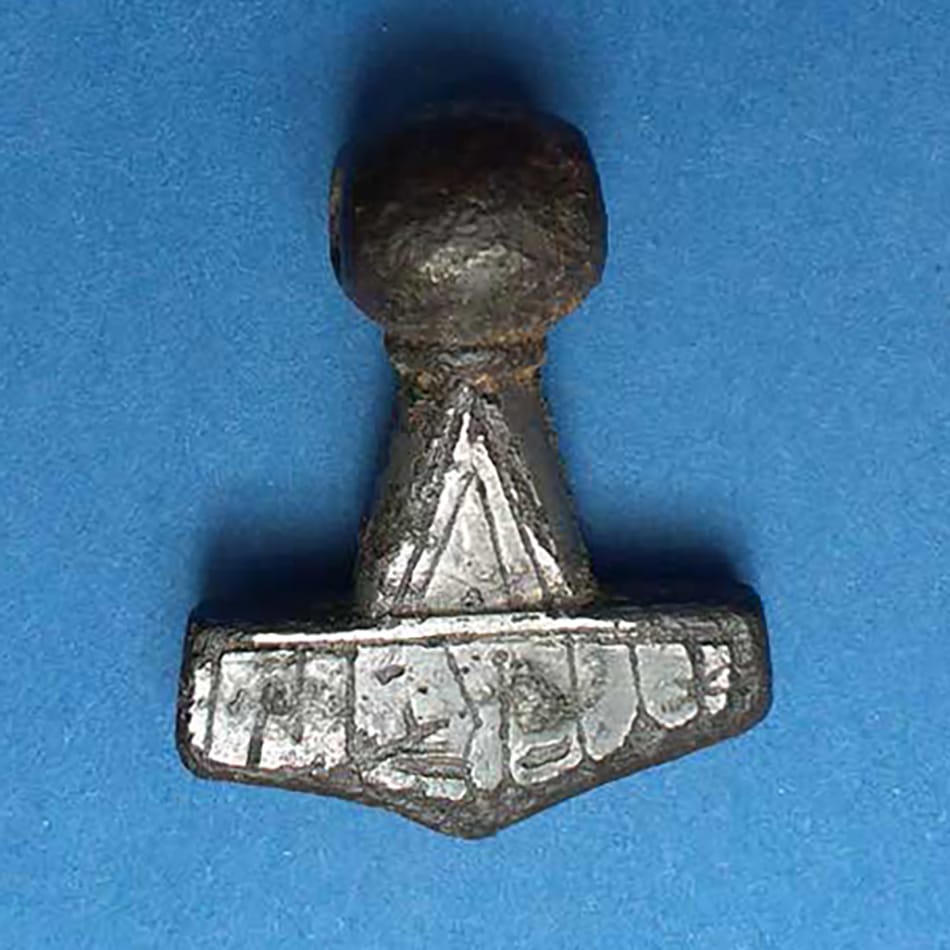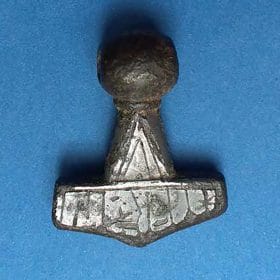
-
Shop by Type
-
Shop by Culture
-
Collections
Home » Blog » Norse & Viking » Thor’s Hammer with Runic Inscription Found on Lolland: A Unique Viking Discovery

The discovery of a 10th-century Thor’s Hammer amulet on the Danish island of Lolland has captured the attention of archaeologists and history enthusiasts alike. Unlike over 1,000 other similar amulets unearthed across Scandinavia, the British Isles, and beyond, this particular artifact stands out for one significant reason: it is the only Thor’s Hammer ever found with a runic inscription.
This find not only confirms that these small amulets represent Thor’s legendary weapon but also provides valuable insights into Viking craftsmanship, literacy, and culture. Below, we delve into the historical importance of this exceptional artifact and its broader implications for our understanding of the Viking Age.
Thor’s Hammer, also known as Mjolnir, was worn by Vikings as a symbol of protection, strength, and divine power. While similar amulets have been found in various locations, what sets the Lolland discovery apart is its runic inscription, making it the only known Thor’s Hammer amulet to bear this kind of writing.
The inscription on the amulet, though not perfectly executed, highlights the growing presence of written literacy during the Viking Age. Viking society was largely oral, with written records primarily found on rune stones and formal monuments. This amulet, however, offers a more personal look at the role of literacy in daily life and suggests that written language held significant cultural value, even in smaller objects.

One of the most remarkable aspects of the Lolland find is the runic inscription engraved on the Nordic Hammer amulet. While over 1,000 similar amulets have been discovered across Scandinavia and other regions, this is the only one confirmed to bear such an inscription.
The runes, while not perfectly crafted, read “Hmar x is”, which translates to “This is a Hammer” in modern English. The “x” here functions as a word separator. This small yet significant detail confirms the long-debated theory that these amulets indeed represent Thor’s Hammer, a symbol of strength, protection, and divine power in Norse mythology.
Interestingly, the inscriber, likely not highly skilled, made a few notable errors. For instance, the proper spelling should have been “Hamar,” and the “S” rune was reversed. Despite these mistakes, the inscription is a rare example of Viking literacy and provides invaluable insight into how the written word was used in everyday objects. This inscription indicates that even in a society primarily dominated by oral tradition, runic literacy was a respected skill, giving the object—and its maker—added significance.
This unique Thor’s Hammer amulet is cast in bronze and exhibits traces of silver, tin, and gold plating. The careful craftsmanship suggests that the amulet wasn’t just a casual object but a finely made piece of jewelry, likely created by a skilled artisan. The craftsmanship indicates a rich local tradition of metalworking and jewelry design, underscored by the fact that fragments of silver needles and brooch molds were also found near the site of discovery.
This points to the possibility that the Lolland amulet may have been crafted by a local Viking jeweler, adding a layer of historical context to the significance of the artifact.
Although the runic inscription on the Lolland amulet is not flawlessly crafted, it offers a fascinating glimpse into Viking writing culture. The discovery of inscribed runes on this pendant highlights the use of written language in personal items, suggesting that literacy, while rare, was valued during this period.
Unlike the formal and often complex inscriptions found on rune stones across Denmark and southern Sweden, the runes on this small pendant appear to be more practical, reflecting the daily use of writing beyond monuments and official documents. It offers a more intimate glimpse into how Vikings may have incorporated written language into personal and religious objects, further enriching our understanding of Viking society.
Thor’s Hammer was a central symbol of protection for Vikings, often worn as a pendant during a time when Christian crosses were also becoming more common. It wasn’t unusual for Vikings to combine these two symbols, seeking protection from both pagan and Christian influences.
This duality highlights the cultural crossroads at which Vikings stood during this era, blending their Norse beliefs with the rising influence of Christianity across Scandinavia.
The discovery of this Thor’s Hammer amulet, alongside other items such as silver needles and brooch molds, strongly suggests the presence of a local Viking jewelry workshop in the area. This adds even more historical significance to the find, offering clues about the local economy and the role of artisans in Viking society. The combination of fine craftsmanship and rare inscription makes this amulet a critical piece of evidence for understanding Viking craftsmanship and their use of written language in non-monumental forms.
The Thor’s Hammer amulet found on Lolland is more than just a piece of Viking jewelry; it is a window into a rich cultural past. Its runic inscription confirms the amulet as a representation of Thor’s mighty hammer, while its craftsmanship speaks to the expertise of Viking artisans. Moreover, the presence of writing on such a small object suggests that literacy was valued and employed in a range of contexts during the Viking Age.
As more discoveries are made, the Lolland find will undoubtedly continue to inform our understanding of Viking culture, symbolism, and their blending of the written word with powerful, protective imagery.
For those fascinated by Viking history, this discovery enriches our understanding of the intersection between craftsmanship and culture in Viking society, shedding light on their ability to create powerful symbols that transcended time.